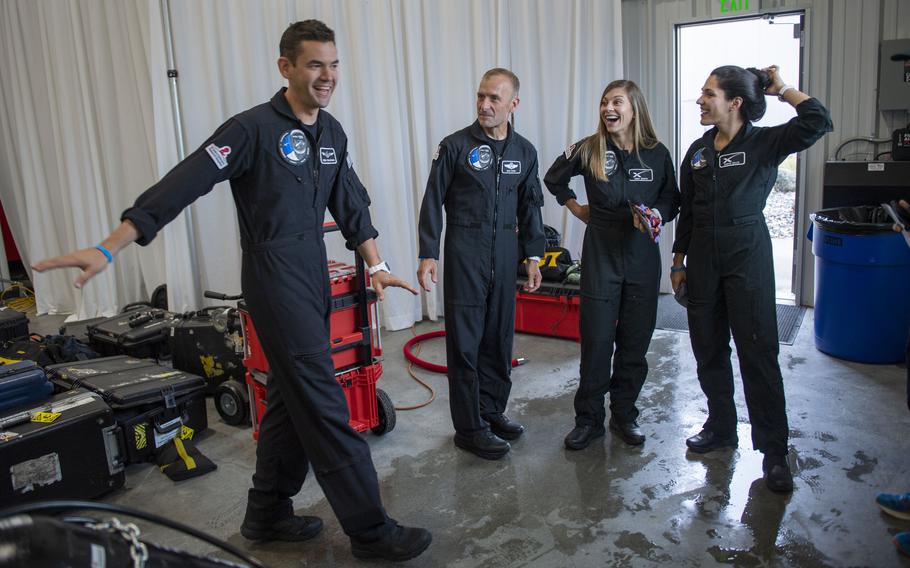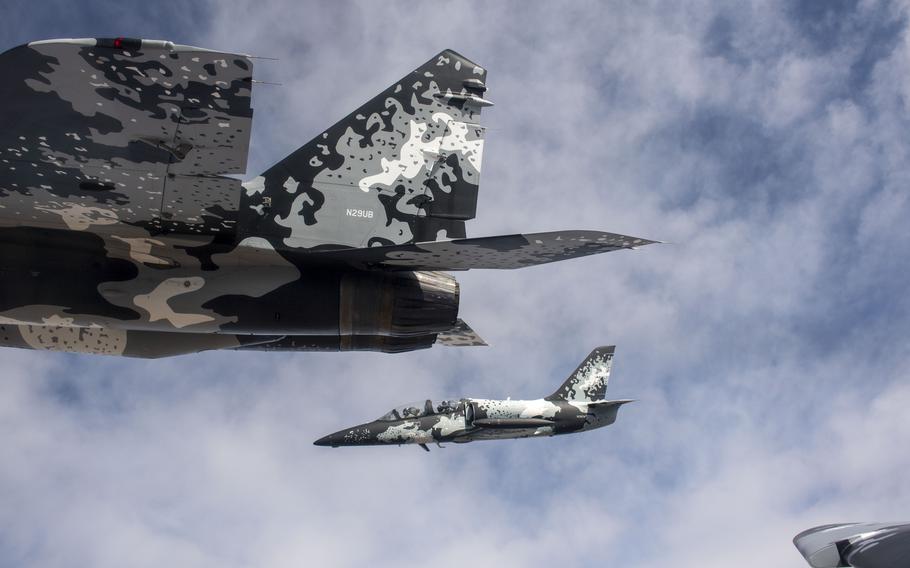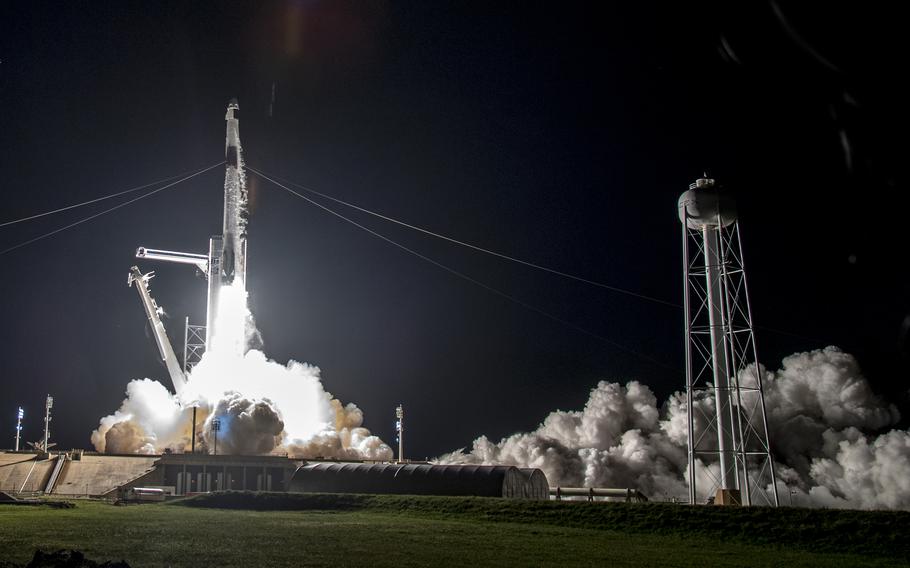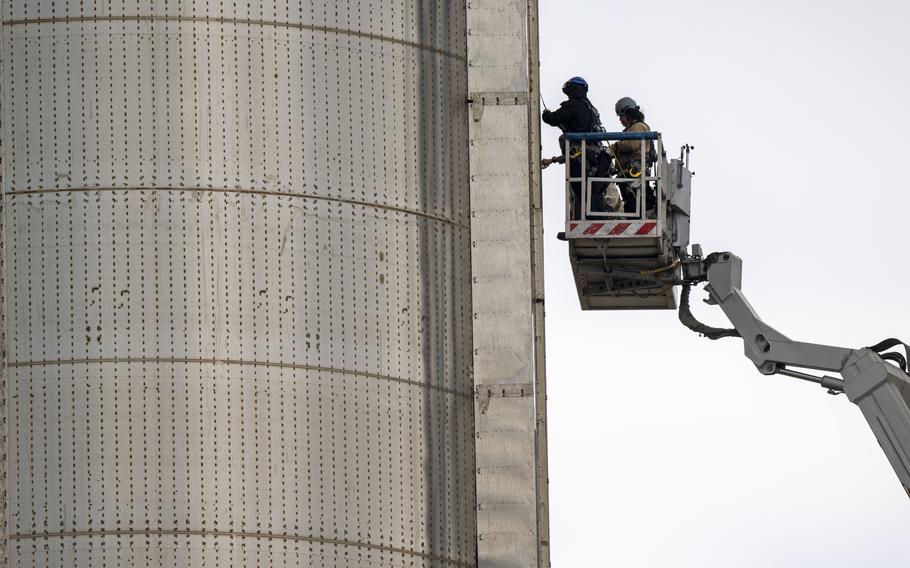
The Polaris Dawn flight crew, from left, Jared Isaacman, Scott “Kidd” Poteet, Anna Menon and Sarah Gillis, in September 2022. (Jonathan Newton/The Washington Post)
HAWTHORNE, Calif. — Three years ago, billionaire entrepreneur Jared Isaacman made history when he led the first all-private astronaut mission to orbit. Now he’s spending more of his fortune on another nongovernment voyage: a SpaceX rocket flight early Tuesday that would put a crew of four in the highest orbit since the Apollo era and, even more dramatically, have them open the hatch and perform the first spacewalk by private astronauts.
If successful, the flight, known as Polaris Dawn, will mark a significant milestone for the commercial space sector as NASA increasingly relies on companies like SpaceX, Blue Origin and Intuitive Machines to build the rockets and spacecraft as well as develop the technologies required for its flagship space endeavors.
For years, NASA has relied on the private companies to fly cargo as well as astronauts to the International Space Station. Now the space agency is also looking to the private sector to build the space stations that would eventually replace the ISS, the spacecraft that would fly them to the surface of the moon, the space suits astronauts would wear while there, and even the rovers that would allow them to explore it more fully.
All of that is a marked change from the days when NASA owned and operated all the hardware and oversaw the missions exclusively. (Jeff Bezos, the founder of Blue Origin, owns The Washington Post.)
Isaacman, who is worth an estimated $2 billion, has not disclosed how much he is paying SpaceX for the flight. He said the Polaris Dawn mission is designed to continue NASA’s pioneering work in an effort to help humans reach the moon and Mars, and eventually spread into the solar system.

Jared Isaacman flies a MiG fighter in formation. Isaacman owns a fleet of fighter jets and is an elite pilot. (Jonathan Newton/The Washington Post)
“SpaceX is doing all the hard work to be at the tip of the spear of commercial space,” the founder of Shift4Payments, a payment processing company, said in an interview here. “We’re playing a small part in it, and we’re choosing to direct that energy towards things that could really move the needle towards the ultimate goal of making life multiplanetary,” he said. “Star Wars or the Jetsons is the future we’re aiming for.”
In addition to Isaacman’s flights, SpaceX has partnered with Axiom Space, a Houston-based company, to fly private citizens to the space station. Recently, SpaceX announced another private astronaut mission, which would fly around the poles of the Earth, the first human spaceflight mission to do so.
The Polaris Dawn mission is the first of three Polaris flights that Isaacman has commissioned from SpaceX. The first would feature the spacewalk. The second was intended to help raise the orbit of NASA’s Hubble Telescope, but NASA has expressed concerns, and the mission is not yet determined. The program would culminate with the first crewed flight of SpaceX’s Starship rocket, the largest and most powerful ever developed, which NASA intends to use to land astronauts on the moon.
Isaacman’s first flight in 2021, called Inspiration4, proved the commercial sector could fly an ambitious mission to orbit without NASA after a group of four private citizens, who had never met before they were chosen for the flight, spent three days in orbit aboard SpaceX’s Dragon capsule.
In the upcoming flight, Isaacman will be joined by Scott “Kidd” Poteet, a retired Air Force lieutenant colonel and fighter jet pilot, as well as two SpaceX employees: Sarah Gillis, who oversees the company’s astronaut training program, and Anna Menon, who serves as a mission director and an astronaut communicator from mission control.
A key objective is to test SpaceX’s spacesuit, which could be vital in the mission to service NASA’s Hubble Space Telescope and raise its altitude. Over the years, the 34-year-old telescope has crept closer to Earth, and by about 2034 it could get near enough to burn up in the atmosphere.
If Isaacman and SpaceX could raise its orbit, NASA would be saved tens of millions of dollars and the life of the telescope would be extended. But the mission has also revealed tensions between a private sector rapidly pushing a new space age and those who fear that NASA’s role is being diminished at the cost of safety and reliability.
The Hubble mission is risky and could also go horribly wrong. Instead of saving the telescope, the crew could damage a national asset, or, worse, endanger their own lives. As a result, some at NASA have bristled at the commercial sector taking over responsibilities that had long been under the government’s purview, as NPR reported earlier this year.

The SpaceX launch of the Inspiration4 crew of civilian astronauts led by Jared Isaacman on Sept. 15, 2021. (Jonathan Newton/The Washington Post)
Isaacman said in the interview that a successful spacewalk would demonstrate his team’s ability to handle a task as complex and dangerous as the Hubble mission.
“I haven’t given up hope on this,” he said. “I still think it will be an absolutely great mission for science and commercial space. I don’t think that door is closed, but if it’s not Hubble, it’ll be something else very meaningful.”
For now, he said, he is focused on the first Polaris flight. Stepping out into the vacuum of space for a spacewalk, also known as an extravehicular activity or EVA, is generally considered one of the most dangerous activities astronauts perform. SpaceX has spent more than two years developing a suit that would essentially serve as a personalized spacecraft for the astronauts, protecting them against radiation and extreme temperatures while making sure they can move freely and communicate with each other and controllers on the ground.
It’s also a slimmer, sleeker upgrade. New technologies, such as a heads-up display that projects data on the visors, make the suits used by NASA astronauts, designed decades ago, look like Michelin-man anachronisms.
“We are going to pave the way by pushing the envelope and learning how to go higher and farther and faster and longer safely,” said Stu Keech, SpaceX’s vice president of Dragon engineering. “And all of that will apply to future human spaceflights. The EVA suit in particular has that end goal of how do you build thousands and then eventually millions for the moon and Mars? That’s really the motivation behind that.”
In the training session here, Isaacman and his crew rehearsed getting in and out of their suits, emerging through the Dragon spacecraft hatch and using special handrails SpaceX engineers call Skywalker.
When the capsule is depressurized for the actual mission, all four crew members will put on their space suits. Then Isaacman and Gillis will take turns exiting the hatch, while tethered to the spacecraft and using the Skywalker rails for stability. They plan to perform several mobility tests but will stay close to the hatch. It should take about two hours to vent and then repressurize the spacecraft.
“We’ve been doing a ton of training to prepare the physical motions of the spacewalk,” Gillis said. “And we’ve done a ton of work as a crew to be ready for every contingency that could arise.”

Workers prepare the SpaceX Starship and Super Heavy rocket on April 18, 2023. (Jonathan Newton/The Washington Post)
Instead of training in a massive pool, as NASA astronauts do, the crew members have been training here at SpaceX headquarters, where the company has designed a special pulley and harness that mimics weightlessness. They’ve also spent time flying in Isaacman’s fleet of fighter jets to get used to heavy G loads, the kinds of strong gravitational forces they will experience during flight. They’ve also spent time mountain climbing, scuba diving and “getting comfortable being uncomfortable,” Poteet said.
“It’s about adaptation to the environment that we’re going to live in for five days in space,” he said during a briefing with reporters recently. “It’s very austere, and we’ve got to get ready for that.”
The mission, which could launch as early as 3:38 a.m. Tuesday, with backup launch times later in the morning, is SpaceX’s first human spaceflight mission since one of its Falcon 9 rockets suffered an upper-stage engine failure in June during a satellite launch. SpaceX said it was able to identify and fix the problem, and the Federal Aviation Administration quickly signed off on its return to flight.
Menon said that she had no reservations about flying after the engine problem and that the quick return to flight is “the way SpaceX does business. They make sure to look at all of the data, get to the root cause, and then develop all of the fixes necessary to get to the other side.”